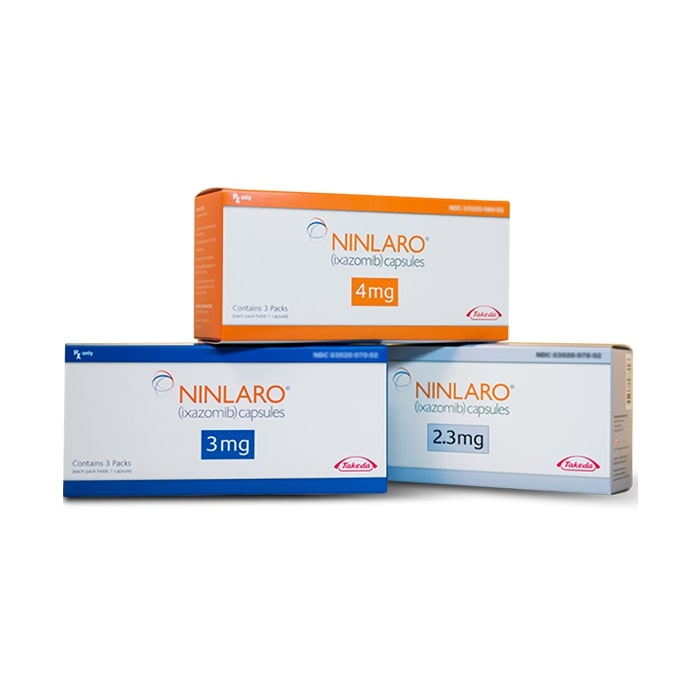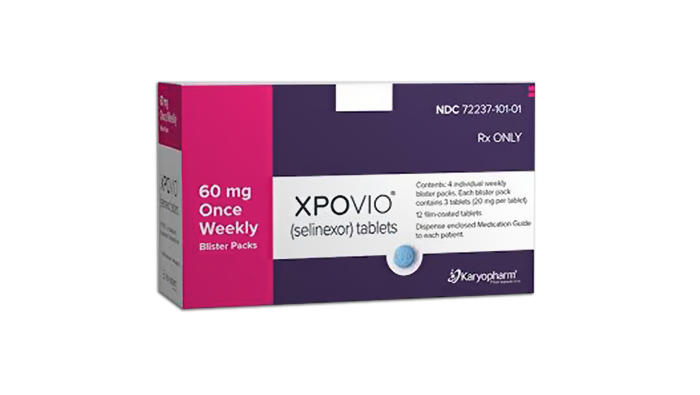Ninlaro (ixazomib) vs Xpovio (selinexor)
Ninlaro (ixazomib) vs Xpovio (selinexor)
Ninlaro (ixazomib) is an oral proteasome inhibitor used in combination with other medications to treat multiple myeloma and works by disrupting the waste disposal system of cancer cells, leading to their death. Xpovio (selinexor) is a selective inhibitor of nuclear export, also used for the treatment of multiple myeloma, but it functions by trapping tumor suppressor proteins within the nucleus of cancer cells, leading to the restoration of their tumor-suppressing functions. The choice between Ninlaro and Xpovio for a patient would depend on various factors including the specific characteristics of their disease, prior treatments, potential side effects, and how the treatment fits into their overall care plan, which should be discussed with their healthcare provider.
Difference between Ninlaro and Xpovio
| Metric | Ninlaro (ixazomib) | Xpovio (selinexor) |
|---|---|---|
| Generic name | Ixazomib | Selinexor |
| Indications | Multiple myeloma | Multiple myeloma, diffuse large B-cell lymphoma |
| Mechanism of action | Proteasome inhibitor | Selective inhibitor of nuclear export (SINE) |
| Brand names | Ninlaro | Xpovio |
| Administrative route | Oral | Oral |
| Side effects | Diarrhea, constipation, thrombocytopenia, peripheral neuropathy, nausea, peripheral edema, vomiting, back pain | Nausea, fatigue, weight loss, low blood counts, hyponatremia, decreased appetite, diarrhea |
| Contraindications | Hypersensitivity to ixazomib or any of its excipients | Hypersensitivity to selinexor or any of its excipients |
| Drug class | Proteasome inhibitor | XPO1 inhibitor |
| Manufacturer | Takeda Pharmaceuticals | Karyopharm Therapeutics |
Efficacy
Ninlaro (Ixazomib) Efficacy in Multiple Myeloma
Ninlaro (ixazomib) is an oral proteasome inhibitor used in the treatment of multiple myeloma, a type of blood cancer that affects plasma cells. It is specifically indicated for use in combination with lenalidomide and dexamethasone for the treatment of patients with multiple myeloma who have received at least one prior therapy. Clinical trials have demonstrated that ixazomib, when added to lenalidomide and dexamethasone, extends progression-free survival (PFS) compared to the two drugs alone. The TOURMALINE-MM1 study, a pivotal phase 3 clinical trial, showed that the median PFS for patients treated with the ixazomib regimen was significantly longer than for those who received placebo plus lenalidomide and dexamethasone.
While the overall survival (OS) benefit with ixazomib has not been definitively established, the improvement in PFS indicates a delay in disease progression, which is a valuable outcome for patients with multiple myeloma. The response rates, including complete response and very good partial response, were also higher in the ixazomib group. The safety profile of ixazomib is generally manageable, with common adverse events including gastrointestinal symptoms, thrombocytopenia, and peripheral neuropathy.
Xpovio (Selinexor) Efficacy in Multiple Myeloma
Xpovio (selinexor) is a first-in-class, oral selective inhibitor of nuclear export (SINE) compound that blocks the exportin 1 (XPO1) protein. It is approved for use in combination with dexamethasone for the treatment of adult patients with relapsed or refractory multiple myeloma (RRMM) who have received at least four prior therapies and whose disease is resistant to several other forms of treatment, including at least two proteasome inhibitors, at least two immunomodulatory agents, and an anti-CD38 monoclonal antibody. The approval of selinexor was based on results from the STORM study, a phase 2b clinical trial, which demonstrated a meaningful overall response rate (ORR) in heavily pretreated patients.
In the STORM study, selinexor, in combination with dexamethasone, showed an ORR of approximately 25% in patients with RRMM. The median duration of response was also notable, considering the heavily pretreated population. While the efficacy of selinexor has been established in this difficult-to-treat population, its use is associated with a unique set of side effects, including nausea, vomiting, fatigue, and anorexia, which require careful management to optimize patient outcomes. Further research and ongoing clinical trials continue to evaluate the role of selinexor in earlier lines of treatment and in combination with other myeloma therapies.
Regulatory Agency Approvals
Ninlaro
-
European Medical Agency (EMA), European Union

-
Food and Drug Administration (FDA), USA

-
Health Canada

-
Pharmaceuticals and Medical Devices Agency (PMDA), Japan

-
Therapeutic Goods Administration (TGA), Australia

Xpovio
-
European Medical Agency (EMA), European Union

-
Food and Drug Administration (FDA), USA

Access Ninlaro or Xpovio today
If Ninlaro or Xpovio are not approved or available in your country (e.g. due to supply issues), you can access them via Everyone.org.
How it works

Make an enquiry
Choose the medicine you want to buy, answer a couple of questions, and upload your prescription to speed things up. We’ll get back to you within 24 hours.


Make an enquiry
Choose the medicine you want to buy, answer a couple of questions, and upload your prescription to speed things up. We’ll get back to you within 24 hours.


Breeze through the paperwork
We'll guide you through the required documents for importing unapproved medicine, ensuring you have all the necessary information.


Get a personalized quote
We’ll prepare a quote for you, including medicine costs and any shipping, administrative, or import fees that may apply.


Receive your medicine
Accept the quote and we’ll handle the rest - sourcing and safely delivering your medicine.

Some text on this page has been automatically generated. Speak to your physician before you start a new treatment or medication.
Let's talk
If you have any questions, call us or send us a message through WhatsApp or email:
Contact us




